The Archives Strikes Back
By Katie Gray, Archivist, Charleston County Public Library
October 7, 2017. High noon. An important professional decision lay before me. I brought to bear my years of experience, knowledge, professional detachment, and discernment. It was a difficult task, but in consultation with the head of our IT department, as well as an Imperial scout and a Rebel princess, a decision was made…
First prize at the Star Wars Reads Day costume competition went to the cutest Jawa this side of Tatooine.
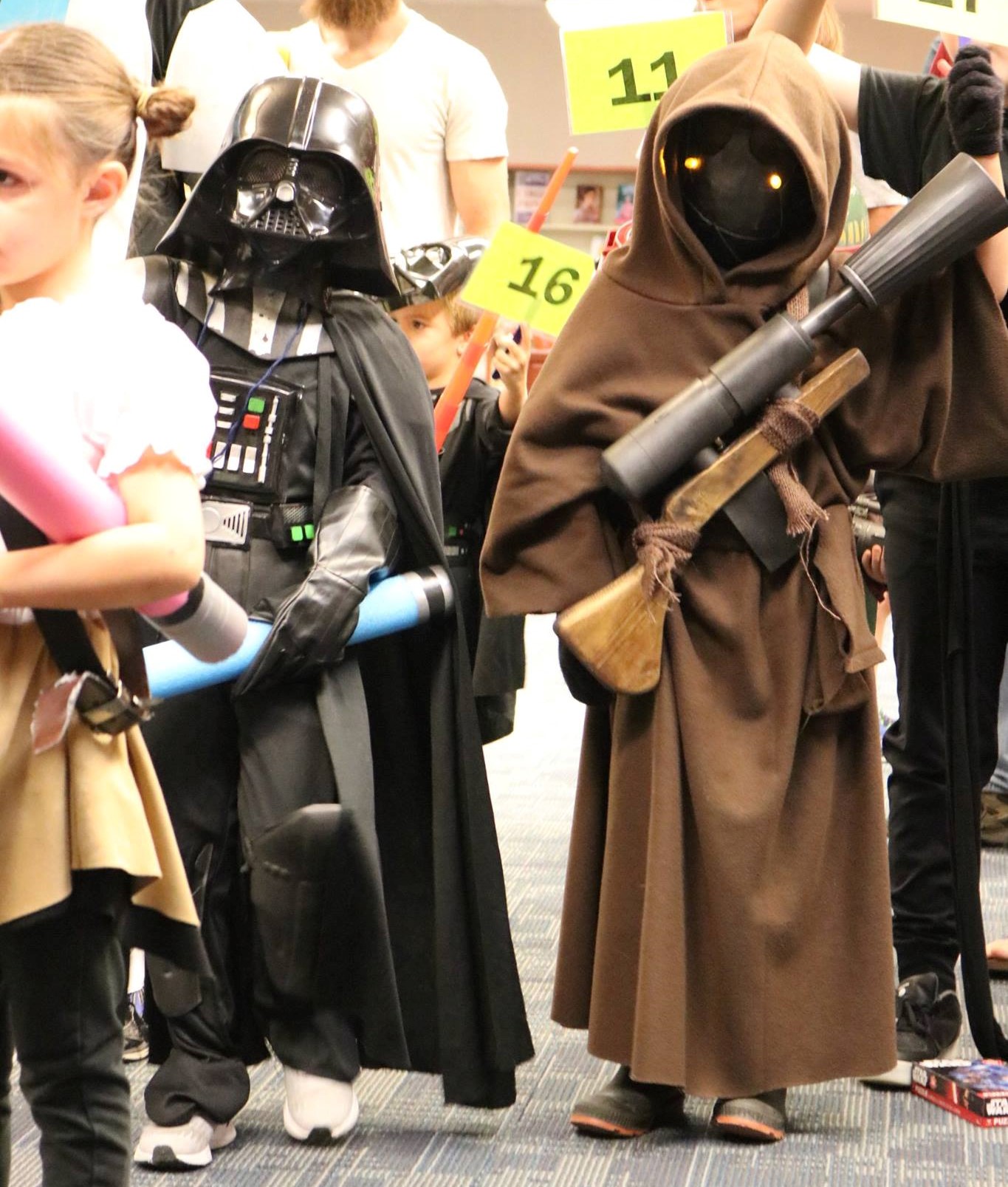
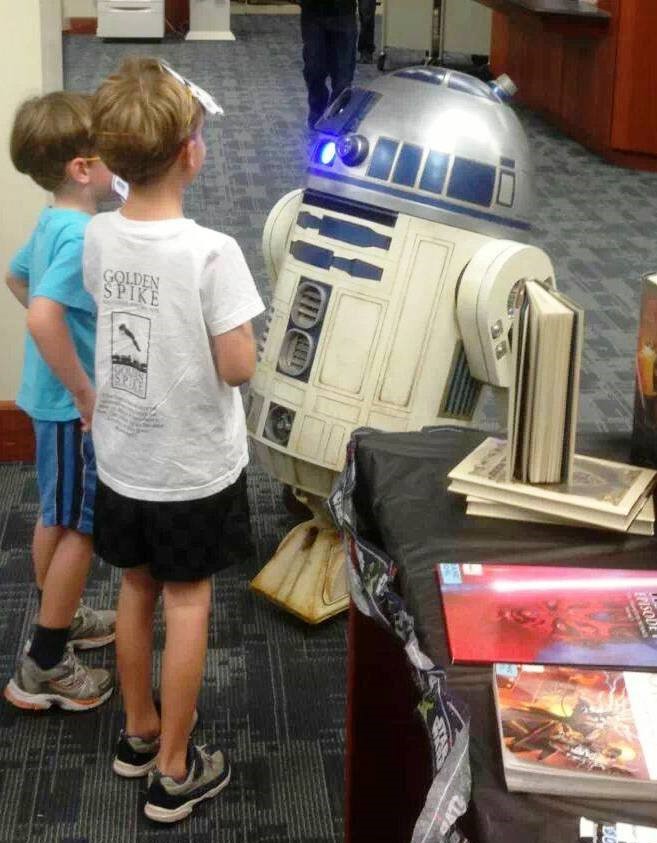
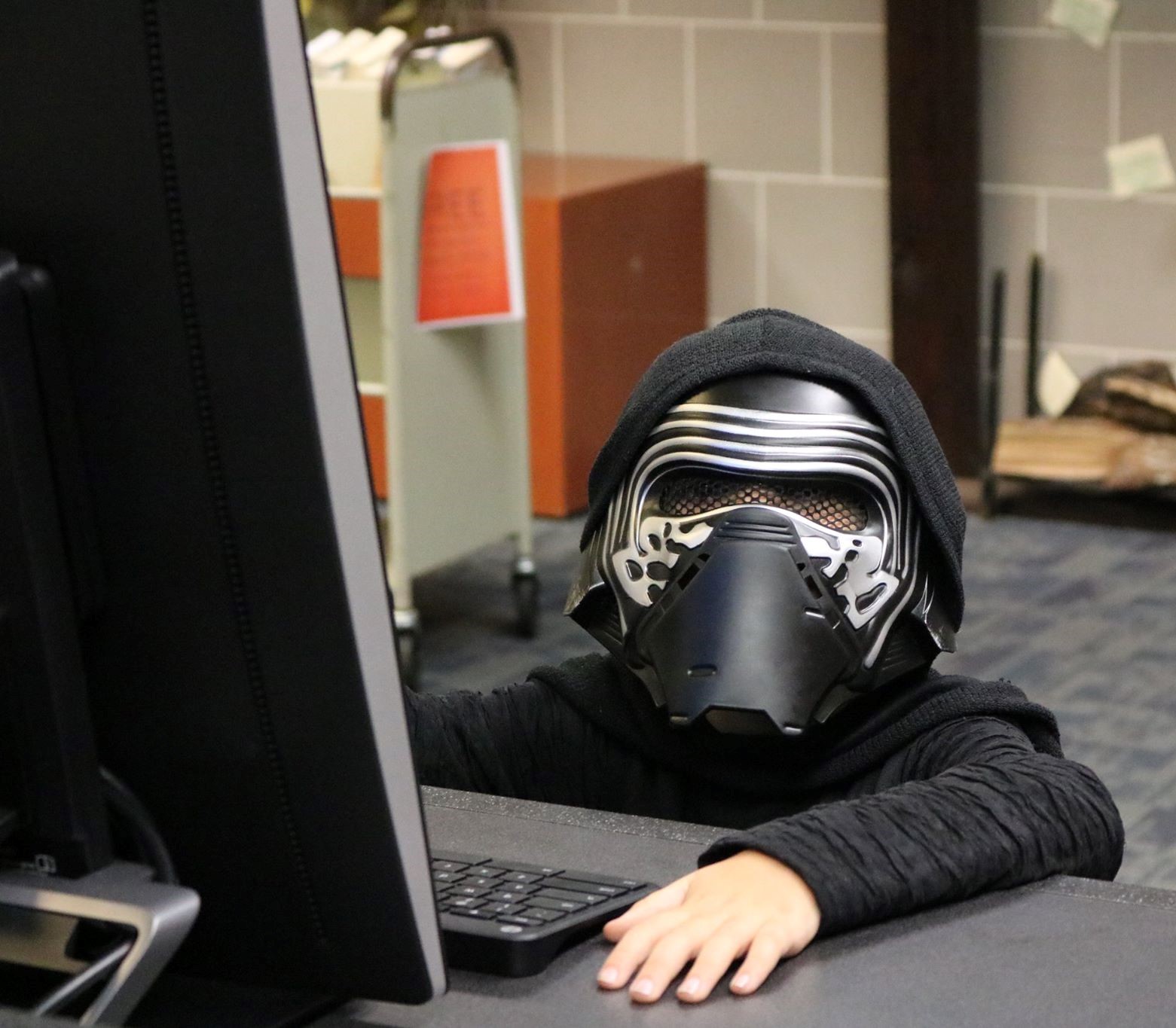
Photos courtesy of Charleston County Public Library.
Clearly, judging costume contests is not a typical task for an archivist. It certainly isn’t covered in Hunter’s Developing and Maintaining Practical Archives. And you‘d be hard pressed to find Star Wars mentioned at all in the professional archival literature. However, this is a task I undertake every fall, and one that I look forward to with delight.
One of the many advantages of working as an archivist in a public library is the opportunity to reach beyond prescribed archival duties and connect with the community on a personal (and oftentimes fun) level. Over the years, I have worked at senior fairs and community gatherings, at Pride festivals and Friends of the Library book sales. I helped stage a fake rare books heist for a Sherlock Holmes mystery lock-in and taught teens about papermaking and bookbinding during summer book camp. Participating in these events has allowed me to bring a little bit of archives and history into everyday library events, which works well, because, in Charleston, no matter where you are or what the occasion, people are always happy to talk about history.
On the surface, it may seem difficult to justify the use of archival staff time for programming and outreach not specifically dedicated to archives and special collections. Of course, an archivist in a public library must still undertake those duties that are the bedrock of the archival profession: arrangement and description, reference and research, cataloging and conservation, and everything in between. As is the case in so many archival institutions, staffing is limited, and responsibilities are numerous. However, the time spent contributing to programs outside the archives can be a good investment for the professional development of the department and the staff.
In practical terms, participating in collaborative public library programming affords the archivist the opportunity to expand the archives’ outreach to groups that normally would not be archives users and at numbers not often seen at archival events. (1900 people at Star Wars Reads Day alone!) It is an excellent way to build internal, institutional interest in the archives and advocate for its importance to the institution, the users, and the community. It also encourages the creation of robust, collaborative relationships with library colleagues. When I first started working in the archive over 10 years ago, I frequently heard, from both staff and patrons, “We have an archive?” “What do you do back there?” or even “Do you collect fines?” (when we were still called Special Collections). Now, thanks to concerted outreach efforts by the archives staff and the historian, staff and patrons know who we are and what we can do for the community.
I take seriously my duty to preserve and make accessible the historical materials that document the public history of the city and county of Charleston. However, I am also cognizant that the work that I do is in support of the overall mission of my institution: to connect our diverse community to information, foster lifelong learning, and enrich lives. I gladly fulfill my dual role as archivist and public librarian. Every connection I make is an opportunity to both educate the community and to cultivate new archives users. After all, you never know who may grow up to be the next great historian or archivist.
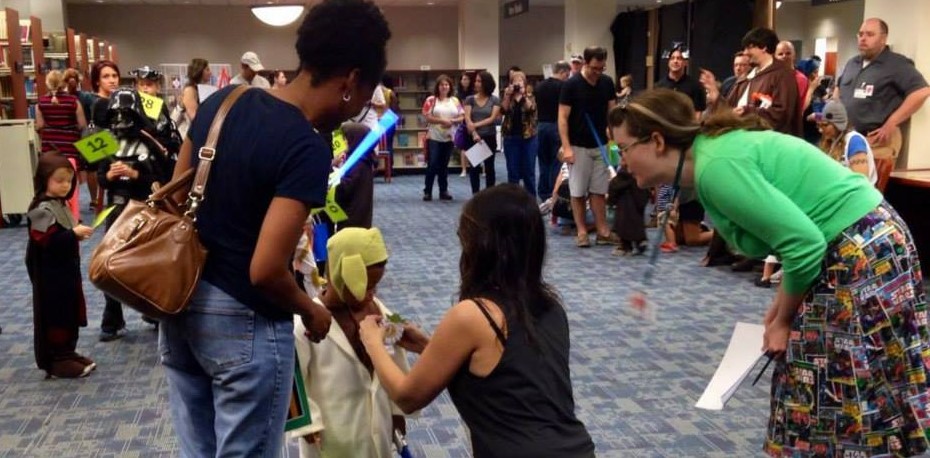
Photos courtesy of Charleston County Public Library.
Lander through the Decades Museum Experience
By April Akins, University Archivist, Lander University
Each summer, Lander University’s incoming freshman class attend one of several orientation sessions. During the sessions, they are given time to explore the history of Lander through an experience with the Lander University Archives. Over the years, with the increase in freshman enrollment finding ways to make this experience exciting and meaningful has become challenging. This summer there were over 750 students to embark on a walk down memory lane. In order to give the students an opportunity to see the archival materials as well as gain knowledge of Lander’s 145-year history, I created the “Lander through the Decades” museum exhibit with the help of a student worker, Janie Sullivan, senior Lander University History Major.
Many students come to Lander having never experienced a museum before so in an effort to provide a learning experience for the students, materials were arranged into mini museum exhibits and placed behind glass on tables within our large group study room. Each mini exhibit was arranged to include several decades sharing highlights of Lander’s history through artifacts and manuscripts. A timeline was displayed to give students further details of events that occurred during the time of the materials. Setting up the museum in this format allowed not only the incoming freshman to view the materials but faculty, staff, and community members were also given an opportunity to see the materials. This was a great way to make the Lander community aware of the archives.
One lesson learned from this project is the need to provide more direction to the orientation leaders that guide the students through the museum. The communication that was shared with the leaders was not clear enough. There seemed to be confusion in how to view the materials. In the past, materials had been placed on tables and display cases out in the open allowing students to touch and browse the materials in a more hands on approach. With preservation in mind, the experience was moved behind glass and set up as a museum to not only provide the “museum experience” for students but to show the importance of preserving the materials. The glass barrier (and locked door) provided safety and security of the archival materials.
One idea for a spin off from this project that was received from a faculty member is to create a virtual museum exhibit with these same materials. The suggestion included having a mass communication and/or a computer science student work to create a digital replication of the exhibit that could be included in our freshman experience course’s online materials. This would also allow us to place the museum on our archives website to provide another avenue to access our materials.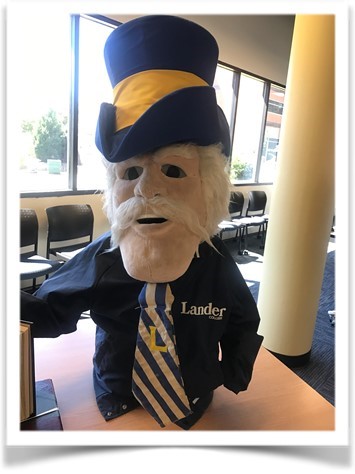

A mascot costume and commencement invitations make up part of the Lander Through the Decades exhibit on display at the Lander University Archives in the Larry Jackson Library.
World War One: At Home and Abroad Exhibit
By Luke Meagher
“World War One: At Home and Abroad” — on display September 22 until December 18, 2017 in the lower level gallery at the Sandor Teszler Library, Wofford College, Spartanburg —shares perspectives of local, regional, national, and international life during The Great War. Through the presentation of facsimiles and originals from Wofford College's Archives and Special Collections the exhibit tells how the war affected the College as well as the city of Spartanburg. Several unique items on display also provide global context for the war.
Wofford's exhibit is accompanied in the gallery by a travelling exhibit developed by faculty and the library at Sewanee: University of the South and funded by the Associated Colleges of the South. The travelling exhibit features narrative historical context and facsimiles of historical items regarding the stateside political and legal environment surrounding the war,with special attention to what life was like for Germans and German-Americans in the U.S. when President Woodrow Wilson declared war on April 6, 1917, a time when domestic anti-German sentiment was already pervasive.
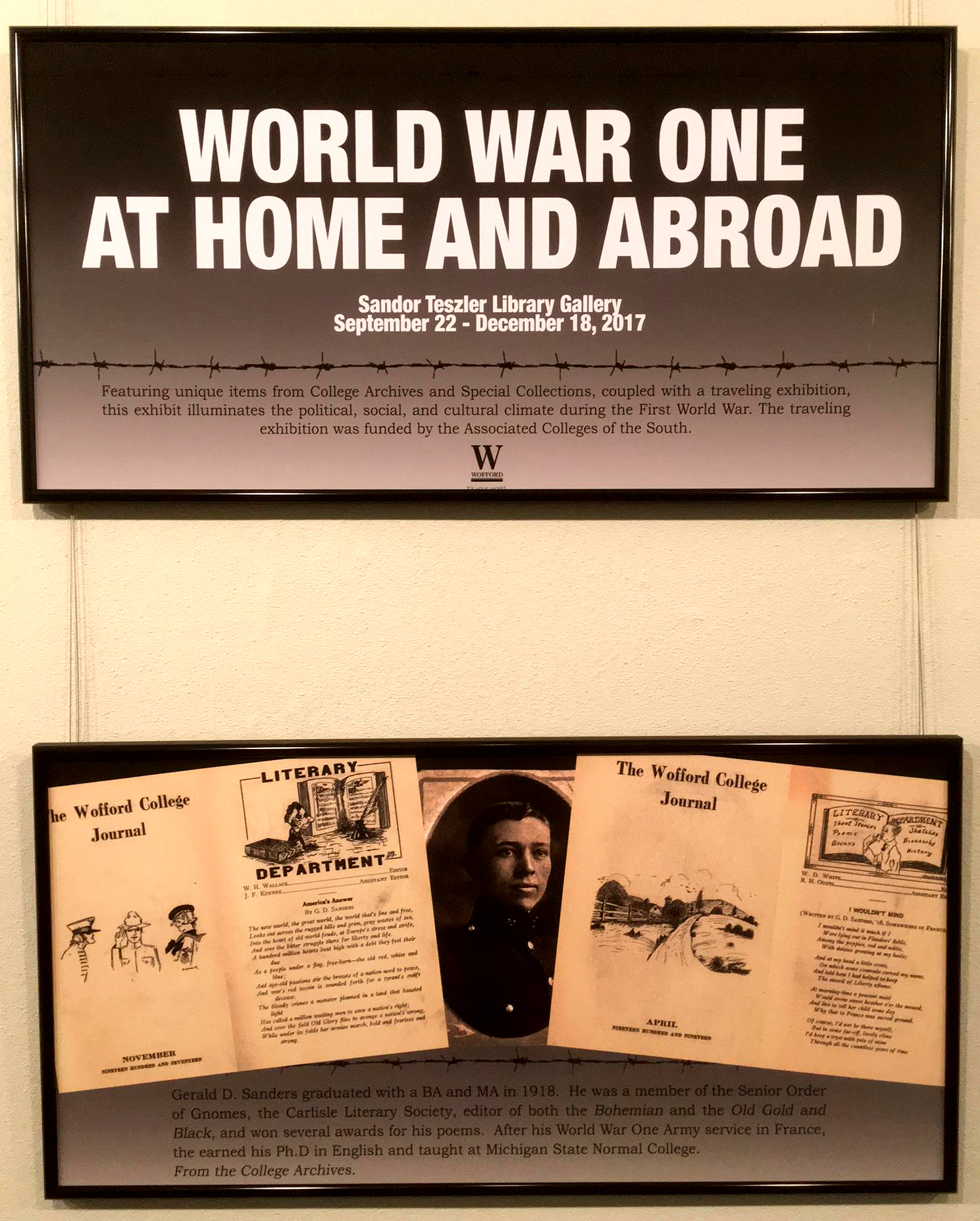

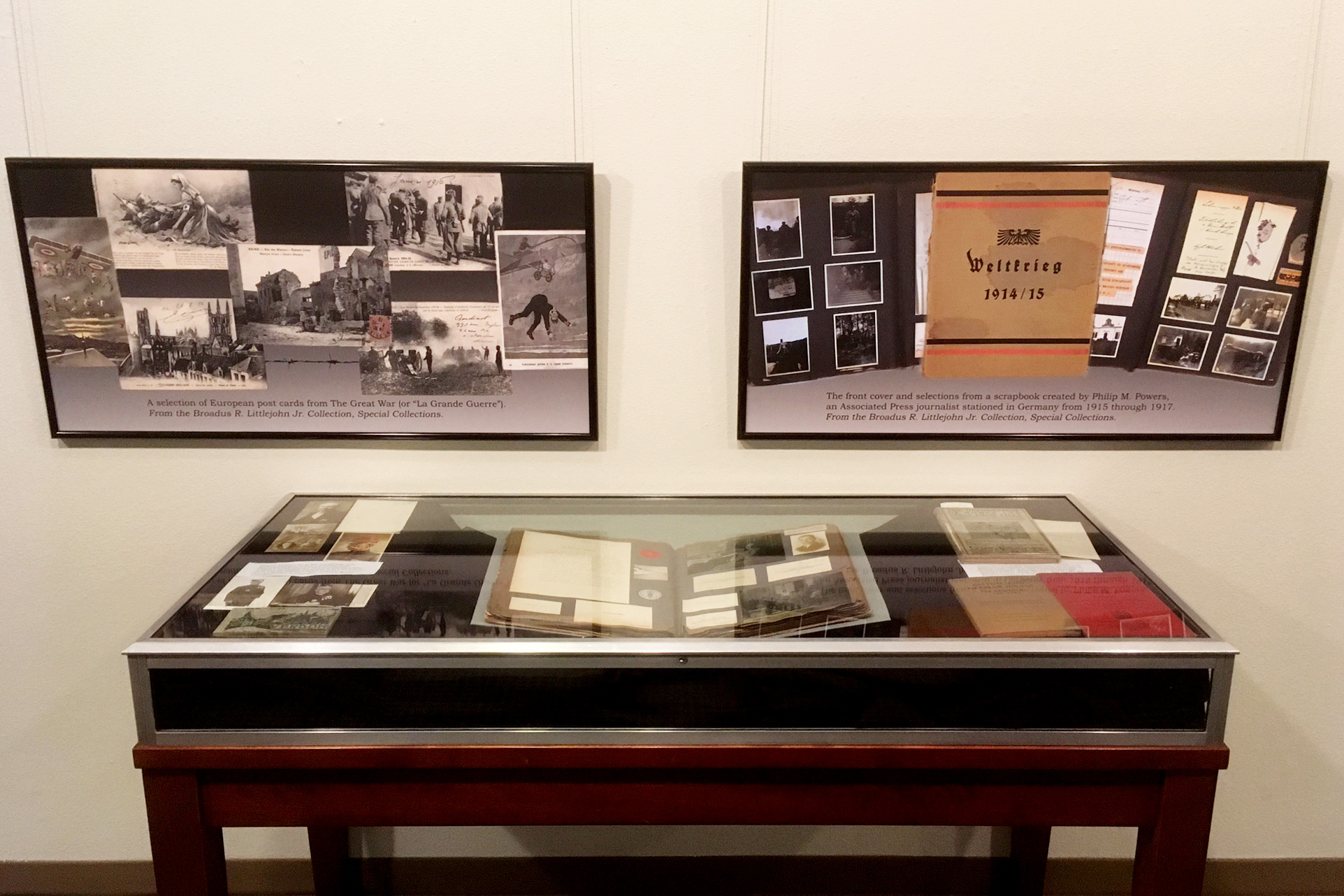

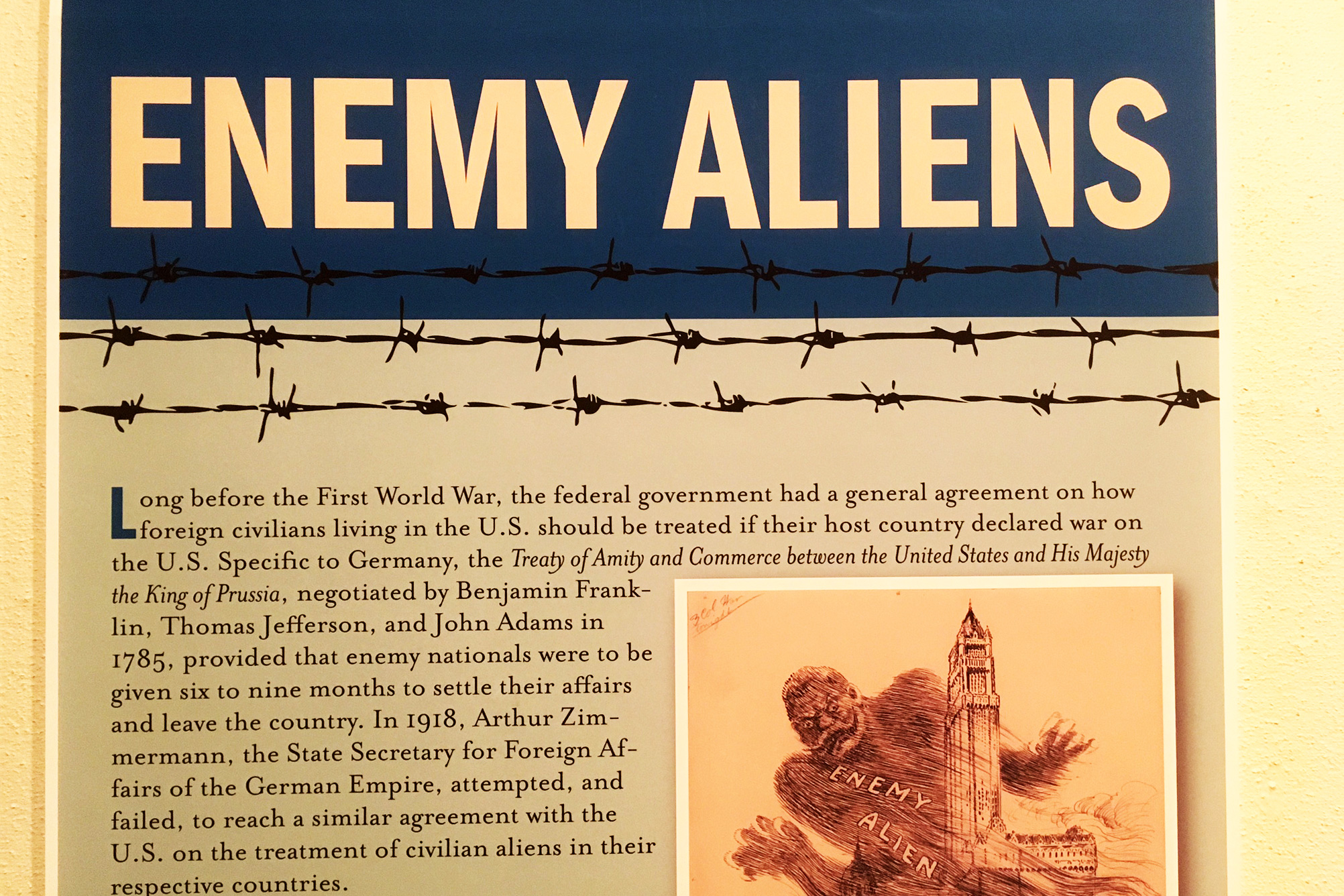
The Story of a House Comes Home
By Karen Emmons, Archivist/Librarian, Historic Charleston Foundation
In July, I received a phone call from Birmingham, Alabama, regarding a donation of historic documents pertaining to the house at 72 Tradd Street in Charleston, the earliest of which dated back to 1765. The call was from the son of the owners of the house from 1980-1995 who discovered the collection of documents among the belongings of his recently deceased mother. I accepted the donation as it seemed like it would enhance the documentation already on file for the large double tenement known as the Fotheringham-McNeil Tenements. My hunch was right! About a week later, the large package arrived, and secured between two wooden covers of this giant book was an archive of several historic deeds and other property conveyance documents dating from 1765 to 1960. These documents represent the entire ownership history of 72-74 Tradd during that time period.
But questions remained: Who had assembled this amazing book and why and how did it end up in Alabama? All of the documents were contained in protective sleeves and many of the oldest ones appeared to have been mended and conserved. The wood cover was carefully crafted, with the address etched onto the front. It was obvious that whoever assembled the book did so out of love for both the house and for the documents. I and my colleague Katherine Pemberton (HCF's Manager of Research & Education) marveled over the contents as we went through the book page-by-page to try to discover a clue. It was there, on the last page … a blueprint drawn for Mr. and Mrs. Thomas E. Thornhill.
Thomas (“Tommy”) Thornhill is well-known and beloved by Historic Charleston Foundation. He is a long-time preservationist, serving on HCF’s Board of Trustees for almost 30 years (including 3 years as president), and he continues to be active. Katherine and I immediately felt that it had to have been Mr. Thornhill who had assembled the book. And so another hunch became reality when Katherine called Mr. Thornhill to tell him about the donation. As soon as she said the words “package from Birmingham,” he knew exactly what the phone call was about and was overjoyed that his beloved book had returned home at last.
As it turns out, Mr. Thornhill had acquired all of the deeds, etc., upon purchasing the house in 1958, and he had the foresight to send the oldest documents to the SC Dept. of Archives & History for conservation. Next, he and his wife stitched three sides of the protective sleeves that had been made. The documents were inserted into the sleeves, thus further protecting them from wear-and-tear. The sleeves were then bound between the two wood covers, held in place by screws, making it possible to easily remove the sleeves. Photographs that illustrate some of the changes made to the house were also added. And finally, using a wood-burning tool, Mr. Thornhill etched the title 72 Tradd onto the cover.
It turns out that the book had been gifted to the new owners when the Thornhills sold it but when the house was left vacant for some time in the 1980s, Mr. Thornhill tried to retrieve it. The owner refused but he didn’t give up and for many years, even after she moved to Birmingham, he continued trying to convince her to return the book to him to no avail. As Mr. Thornhill shared with me and Katherine, “I never stopped thinking about that book or wishing it would return to Charleston.”
Mr. Thornhill’s wish came true and so the book he created has come full circle. The "story" of 72 Tradd Street has come home in remarkable condition! Hopefully, the book will be digitized and added to HCF's many collections on the Lowcountry Digital Library. The original will remain safe in HCF’s Archives and accessible to researchers.
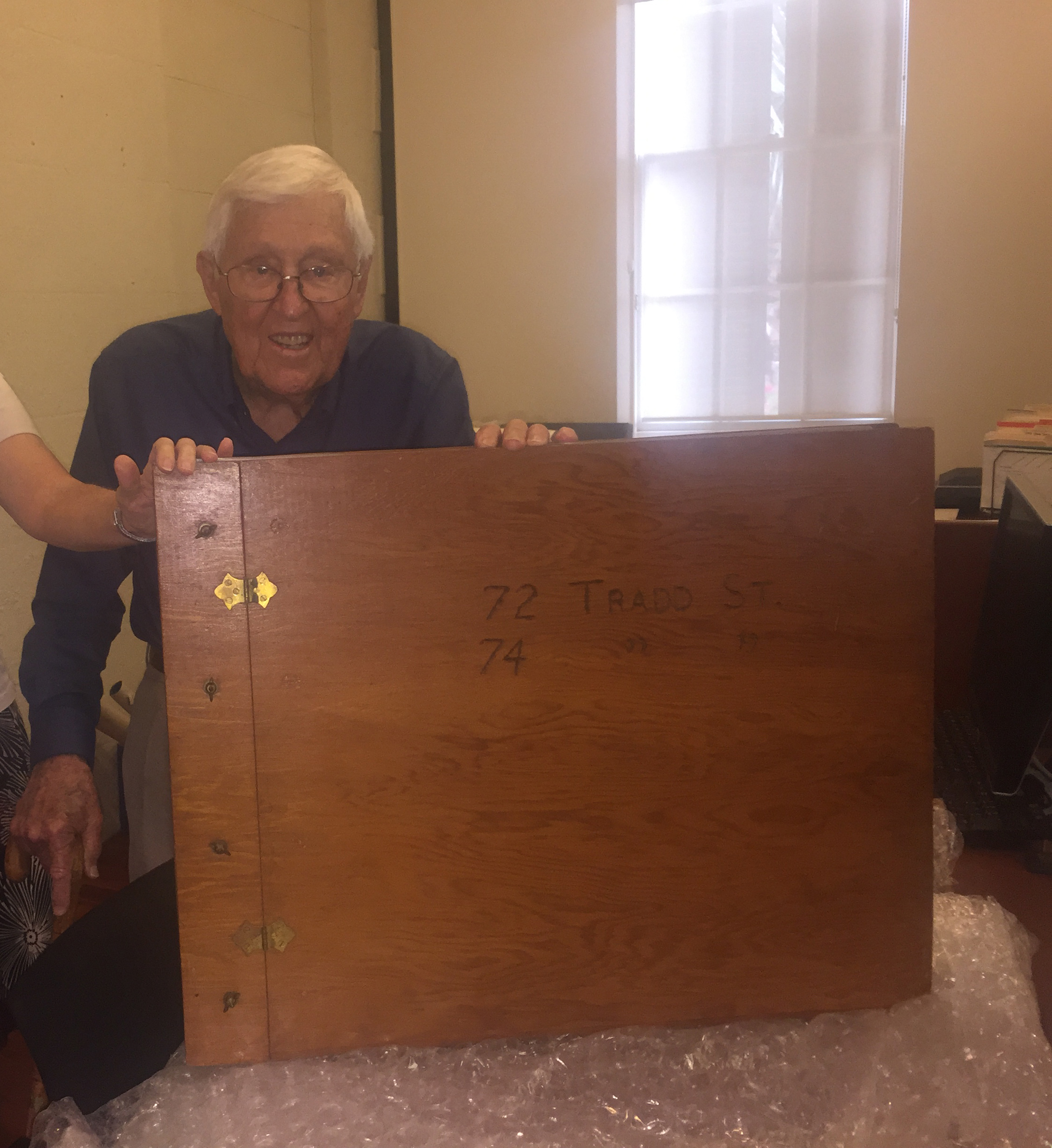 Thomas Thornhill with the book containing documents regarding the Fotheringham-McNeil Tenements in Charleston, SC.
Thomas Thornhill with the book containing documents regarding the Fotheringham-McNeil Tenements in Charleston, SC.
Summer Interns at the Historical Center of York County, SC
By Nancy Sambets, Director of Archives
We had a productive summer at the Historical Center of York County accomplishing a great deal in a short amount of time. In addition to our five long-term volunteers, who focus on abstracting names from court records, we had six interns offer to spend their summers in the archives. Although unpaid, we do offer a climate-controlled environment, flexible schedule and free snacks in the break room. Prospective interns complete an application and interview for the opportunity to work in the field.
Outnumbering staff two to one, our interns this year included graduate students from Winthrop University and the University of Tennessee, rising sophomore from Furman University, rising senior from Lander College, recent undergraduate from Clemson University, and a recent master’s graduate from the University College in Dublin. Several seeking school credits. Although not a requirement, each of them had an interest in history and archival practices. While that may not seem unusual to most, some of our previous summer interns have had backgrounds in art, business, and education. They were also some of our most focused interns who left with a greater appreciation for keeping organized records.
This summer we were able to concentrate our efforts on processing large collections that had been waiting for dedicated attention beyond “at least they are in acid-free storage cartons”. So we got down to business and shared the work. Paul Laffredo, from Winthrop University, has spent 7 months processing a very large collection of general mercantile records which include automotive, cotton and banking industries spanning almost 100 years of receipts, ledgers, correspondence, and financial records. He has decided to turn this project into his master’s thesis and has spent time gathering research and oral histories. Staff is looking forward to the final product.
Sarah Breaux, recent master’s graduate from the University College, has spent the past 10 months processing a large collection of business records related to coal and cotton industries as well as personal papers of the business owner. The current spreadsheet has over 600 entries identifying the contents of each folder. We aim to consolidate some of the folders, reorganize the boxes to eliminate duplication, and re-create continuity. Hopefully our intern will be able to complete the project before she is gainfully employed by a very fortunate institution.
One of the most daunting collections we began processing this summer with our interns Eleanor Mixon from Furman University, Chloe’ Doster from Lander College, and Sarah Marshall from Clemson University was a photographic collection from a photographer’s studio spanning 4 decades of portraits from the 1940s to 1970s. They have successfully sorted hundreds of letter-sized envelopes filled with negatives and prints into chronological order. A process that has already yielded 40 record storage boxes and we have not yet finished the final decade. They are happy to leave a legacy for other interns to emulate. In the following summers, new interns will have the opportunity to process a box or two until the entire collection is alphabetized, scanned, rehoused and every name entered into a spreadsheet.
To stay on top of things, we had our graduate student Carleigh Isbell from the University of Tennessee work on recently donated collections processing family papers from the 1800s, materials related to a local textile plant, and 1950s accident photographs from a former local policeman. Her practical experience in the archives not only benefitted staff but also satisfied her master’s degree requirement. With new accessions in her capable hands, staff had time to focus on tackling the larger collections.
And our work continues…patrons visit to research their ancestors, donors bring us family papers, the local historical society partners with us for state historical markers and interns continue to impress us with their dedication and enthusiasm to help preserve York County’s history. Of our six interns this summer, three will continue until the end of the year. We deeply appreciate their time and assistance; from May through July our interns collectively contributed 362.5 hours. The most memorable intern quote overheard was “I had no idea this much happens in an archives!”
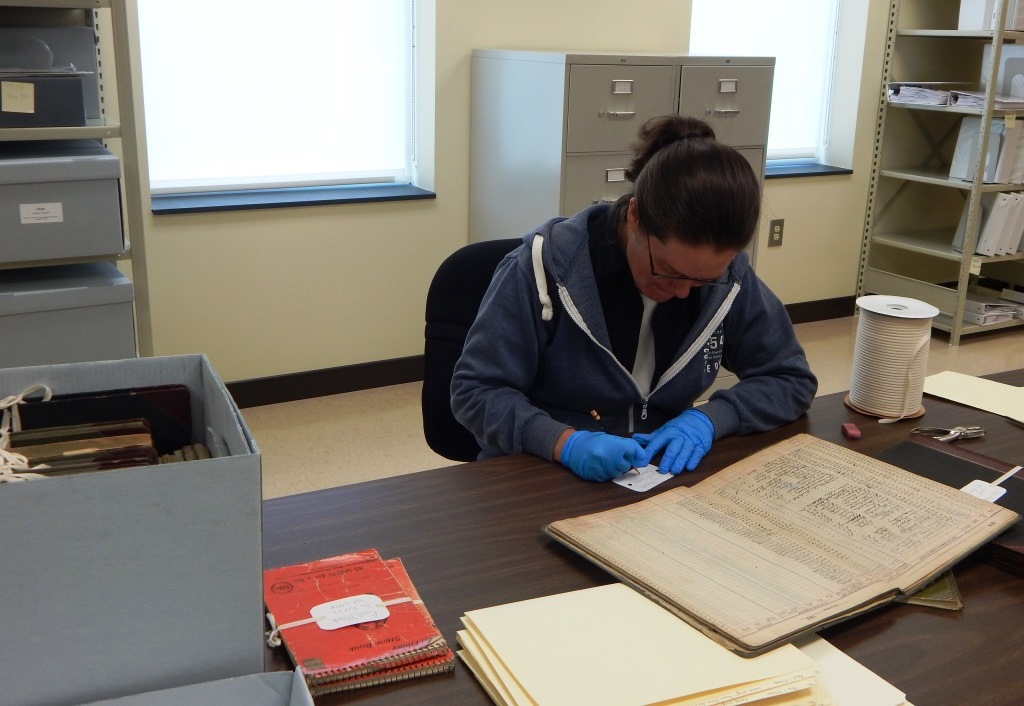
Page 24 of 34
